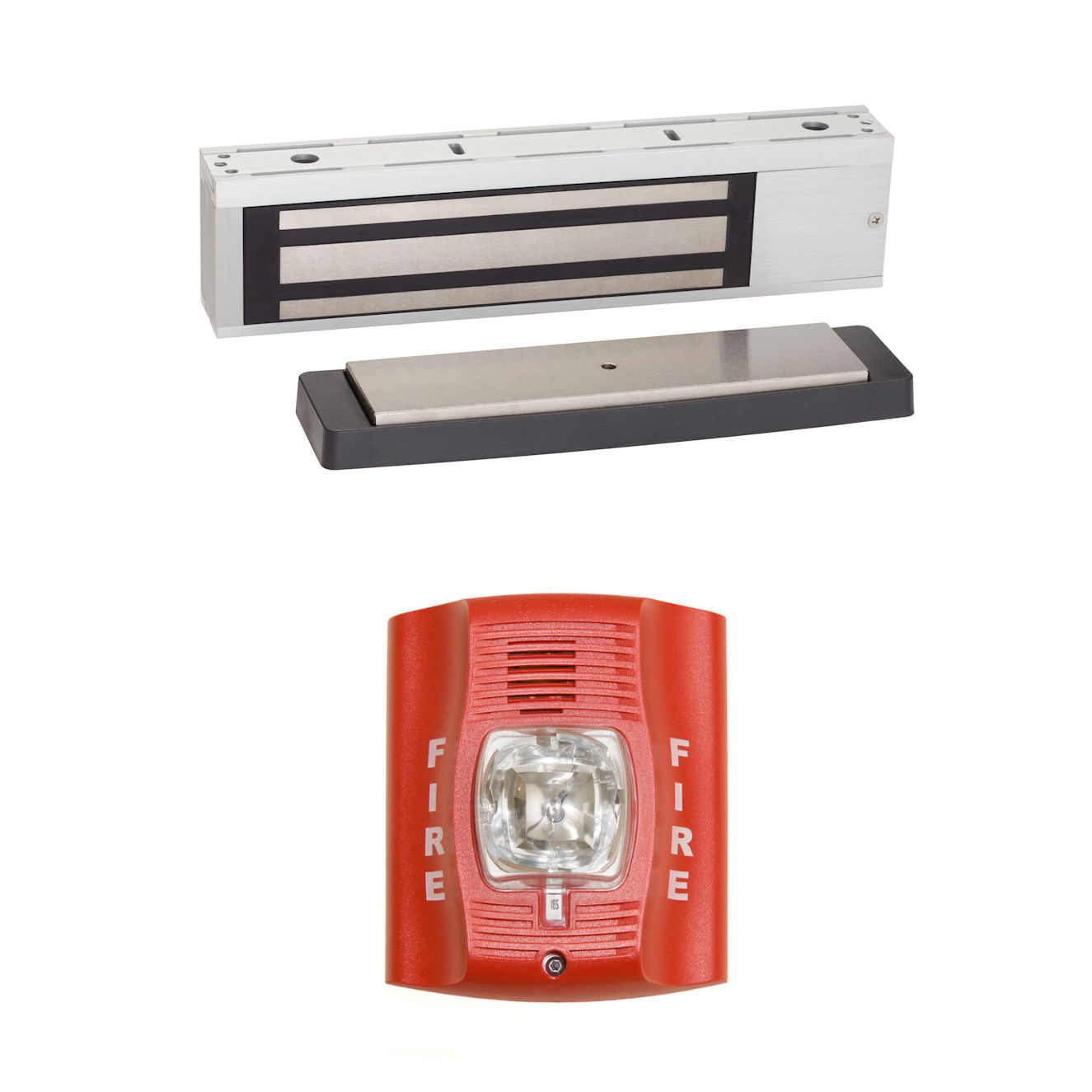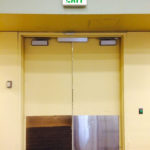 I have written about this topic from various angles, but this Quick Question keeps coming up:
I have written about this topic from various angles, but this Quick Question keeps coming up:
Is it code-compliant to have an electrified lock that is normally locked on the egress side, if it unlocks automatically upon fire alarm activation?
The short answer: In most cases, no.
The long answer:
Doors that are part of a required means of egress and doors that are provided for egress purposes must allow free and immediate egress at all times, with a few exceptions. The International Building Code (IBC) includes the following locations where the egress requirements differ:
- Places of detention or restraint – This is intended to apply to Group I-3 occupancies, like jails or prisons. For these facilities where building occupants are not allowed to evacuate during a fire, the IBC includes detailed criteria to help ensure life safety with a defend-in-place strategy.
- Doors with delayed egress locks – When a door is equipped with a delayed egress lock, the lock may delay egress under normal operation. The delay is limited to 15 seconds, or 30 seconds where approved by the Authority Having Jurisdiction (AHJ). When an attempt to exit is made, the lock must release for egress after the 15/30 second delay, and the lock must release immediately (no delay) upon fire alarm activation and power failure.
- Controlled egress locks in health care facilities – In health care units where the clinical needs of patients or residents require containment for their safety or security, egress doors may be locked until evacuation is needed. There are detailed requirements in the model codes including the means of releasing the doors for egress by staff, fire alarm activation, remote release, and power failure.
- Elevator lobby egress doors – The 2024 edition of the IBC will include a new section addressing fail safe electrified locks on doors serving elevator lobbies. Some state codes and NFPA 101 – Life Safety Code include similar requirements for these doors, which must unlock upon fire alarm activation and power failure. In addition, the elevator lobby must have a two-way communication system to allow a building occupant to call an approved, constantly-attended station.
In addition to the examples above, there are a few locations where locks that could prevent egress are allowed by the IBC. Key-operated locks are allowed for the main entrance doors to a building or tenant space in some occupancies, if the requirements stated in the code are met. Doors serving unoccupied roofs may be locked to prevent access to the building, and egress doors serving exterior spaces may have double cylinder deadbolts under certain circumstances. (Click the links for more info on these applications.)
For doors that are not covered in one of these exceptions, the IBC requires doors to unlatch for egress with one releasing motion*, and with no key, special knowledge, or effort. Latch-releasing hardware must be mounted between 34 inches and 48 inches above the floor**, and must be operable without tight grasping, pinching, or twisting of the wrist***.
So back to the original question…if an electrified lockset is installed on a door in a means of egress, is it acceptable for the lock to prevent egress during normal operation as long as it unlocks automatically upon fire alarm activation? The idea that it’s ok to lock a door in this way is very common, but this is not code-compliant for most locations. If the door is in a detention center, behavioral health treatment facility, or health care unit where the people receiving care require containment, locked doors in a means of egress may be acceptable. If a door is equipped with a code-compliant delayed egress lock, egress may be delayed for 15/30 seconds. If the adopted code allows elevator lobby doors to be locked, and the door in question serves an elevator lobby, the door may be locked if the code requirement are met.
If the door is not installed in one of these locations, or does not meet the criteria listed in the code, an electrified lock that is only unlocked upon fire alarm activation would not be code-compliant. An AHJ may allow it, but in my experience, that is not common.
Do you have any insight on this type of application? Share it in the comments!
*The IBC includes an exception for dwelling unit entry doors, where a second releasing motion is allowed.
**Some state codes specify a different allowable range for the mounting height of hardware.
***Most doors are required to comply with the accessibility requirements, but there are some exceptions.
You need to login or register to bookmark/favorite this content.










Hi Lori. As you correctly noted, the Model Codes require the lock to release upon loss of power to the device. Does it also note that the lock must release upon loss of power to the device that UNLOCKS the door. I have seen this a number of times, particularly with the older TSB devices and REX motion detectors (a simple problem to fix, IF someone knows about it).
On a related matter, what does “Power to the device” mean? I typically provide 4-8 hour back up power to the locks operating at full load (i.e. powered up). I brought this issue up with the AHJ’s in different states and got differing judgements. It’s one reason I am incredibly careful about the use of mag locks. What does the MC’s say about this? How about earlier versions?
Hi Jim –
Here are some examples from the IBC. For sensor-release locks, it says:
The electric locks shall be arranged to unlock by a signal from or loss of power to the sensor.
Loss of power to the lock or locking system shall automatically unlock the electric locks.
For electrified locks released by a switch in the door-mounted hardware:
Loss of power to the electric locking system automatically unlocks the door.
Delayed egress locks:
The delay electronics of the delayed egress locking system shall deactivate upon loss of power controlling the lock or lock mechanism, allowing immediate free egress.
Elevator lobby egress doors (2024):
The electric locks shall unlock on loss of power to the electric lock or electrical locking system.
The battery backup question is still kind of a grey area. I wrote about it here: https://idighardware.com/2020/06/qq-battery-back-up/. It’s on my wish list for the next code cycle.
– Lori
In the City of Chicago, mag locks are not permitted to be connected to any form of back-up power. However, the surrounding suburbs can be entirely different. But Chicago writes their own codes.
Joe. You are definitely correct about Chicago. I have met with the FM there on this very issue years ago…. not a real friendly encounter. It may interest you to know that a system I designed was the first to use Delayed Egress in the City.
FYI never use a Maglock or Fail Safe Electric-Strike on any Fire Rated Openings…Fail Secure Electric-Strike is OK.
Hi Charlie –
It’s ok to use a mag-lock on a fire door if the lock is listed to UL 10C and there is latching hardware in addition to the mag-lock and all of the egress requirements are met. Here is more info on that: https://idighardware.com/2018/07/qq-mag-locks-on-fire-doors/. Electric strikes also have to be listed to UL 10C for use on a fire door assembly, and a fail safe strike would not meet the latching requirement, as you said. Here’s an article about electric strikes on fire door assemblies: https://idighardware.com/2012/06/electric-strikes-on-fire-doors/.
Thanks for commenting!
– Lori
Lori – in a local high school, every perimeter door is secured with a mag lock. They do release on active fire alarm and loss of power. Otherwise, there are a few doors with either an override key switch inside, or a card reader inside and outside to momentarily unlock the door. I am terrified every time I enter the building. I am told the AHJ approved this, and I am afraid to ask.
That is absolutely terrifying! I’m shocked!
– Lori
Wow. Hope the guy got this in writing, The problem with mag locks is that i have yet to see one designed correcty. Its not the lock that bothers me; its the incorrect install.
Although I don’t typically use such locks in my designs, there is a big advantage to using them: Its the only device that will actually tell you the door is actually locked.